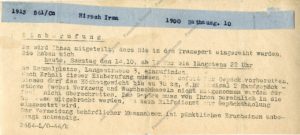Transport of Jews from the Terezin Ghetto to Auschwitz-Birkenau in Autumn 1944
The historical-documentary exhibition of the Terezin Memorial was created to honour the 70th anniversary of the last wave of transports from the Terezin ghetto to the concentration and extermination camp in Auschwitz-Birkenau. The exhibition is designed for both the professional and lay public and is divided into two main parts closed by a clear calendar of events in the autumn of 1944.
The first general part documents the development, progress and impact of the transport waves on the Terezin prisoners in September and October 1944. Among others, it brings important and often first published documents concerning prisoners’ responses to the upcoming transports (absence, mandatory placement, voluntary registration for a transport). The horror of transports is also monitored in the diaries of Terezin prisoners (Alisah Shek) or in the correspondence held in a neutral foreign country (Fritz Ullmann).
The second part of the exhibition is then devoted to several profiles of the Terezin prisoners. Of the many thousands of deportees in autumn 1944, we would like to introduce some of the personalities who participated in the organization of life in the Terezin ghetto. Among them shall be the leaders of the government as well as of various religious and hobby groups, the representatives of athletes and artists. This overview also contains information about the fate of children deported to the death, as well as their leaders. The sad story of a single rabbi active in the Terezin ghetto shall also be presented.
Both parts of the exhibition will be accompanied with rich documentary material from the collections of domestic and foreign institutions and will also offer original documents, drawings and three-dimensional objects.
The exhibition is situated in the Small Fortress on the IVth yard, cel No. 42, in term: July 17th – October 31st, 2014.
Fe


